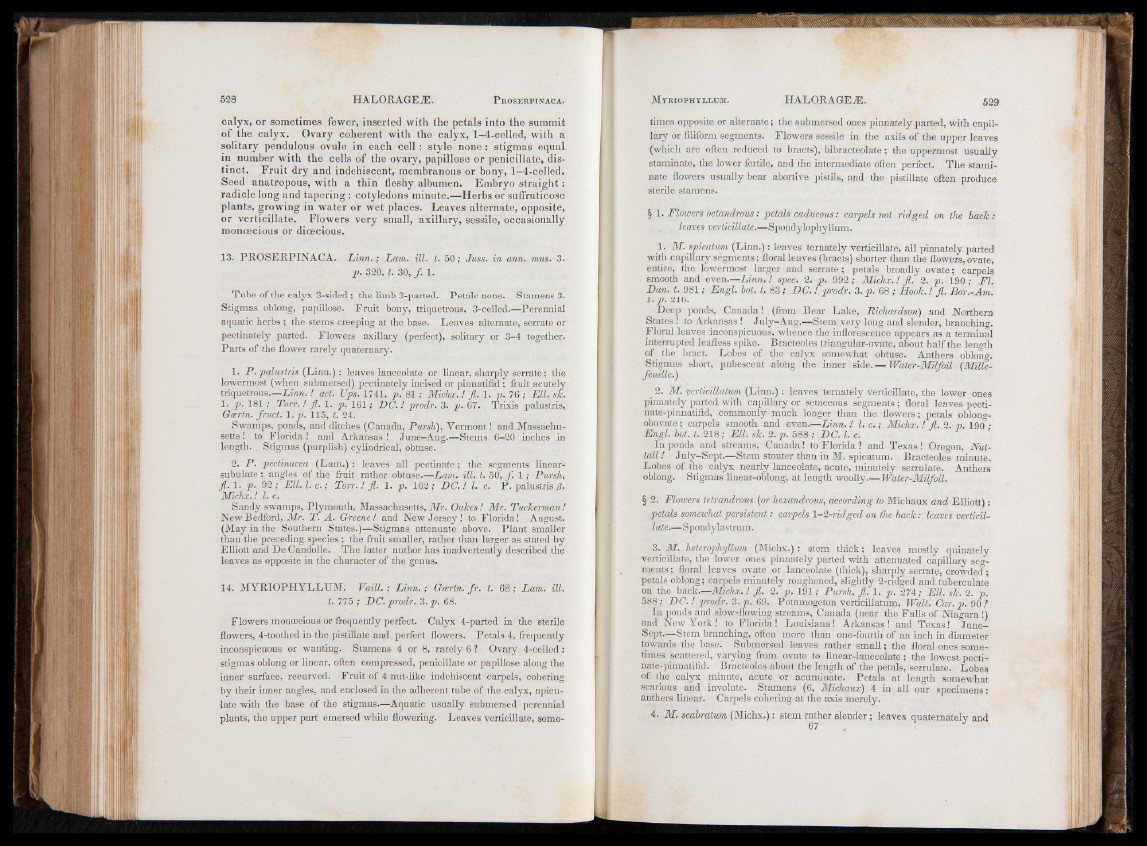
calyx, or sometimes fewer, inserted with the petals into the summit
of the calyx. Ovary coherent with the calyx, 1-4-celled, with a
solitary pendulous ovule in each c e ll: style n o n e : stigmas equal
in number with the cells of the ovary, papillose or penicillate, distinct.
Fruit dry and indehiscent, membranous or bony, 1-4-celled.
Seed anatropous, with a thin fleshy albumen. Embryo s tr a ig h t:
radicle long and tapering : cotyledons minute.—Herbs or suffruticose
plants, growing in water or wet places. Leaves alternate, opposite,
or verticillate. Flowers very small, axillary, sessile, occasionally
monoecious or dioecious.
13. PROSERPINACA. L in n .; Lam. ill. t. 50; Juss. in ann. mus. 3.
p. 320, t. 30, ƒ. 1.
Tube of the calyx 3-sided ; the limb 3-parted. Petals none. Stamens 3.
Stigmas oblong, papillose. Fruit bony, triquetrous, 3-celled.—Perennial
aquatic herbs ; the stems creeping at the base. Leaves alternate, serrate or
pectinately parted. Flowers axillary (perfect), solitary or 3-4 together.
Parts of the flower rarely quaternary.
1- P ■ palustris (Linn.): leaves lanceolate or linear, sharply serrate; the
lowermost (when submersed) pectinately incised or pinnatifid ; fruit acutely
triquetrous.—Linn. ! act. Ups. 1741, p. 81 ; Michx. ! f l . l . p. 76 ; Ell. sk.
1 . p. 181 ; Torr. ! fl. 1 . p. 161; DC. ! prodr. 3. p. 67. Trixis palustris,
Geertn. fruct. 1. p. 115, t. 24.
Swamps, ponds, and ditches (Canada, Pursh), Vermont! and Massachusetts
! to Florida ! and Arkansas ! June-Aug.—Stems 6-20 inches in
length. Stigmas (purplish) cylindrical, obtuse.
2. P. pectinacea (Lam.): leaves all pectinate; the segments linear-
subulate ; angles of the fruit rather obtuse.—Lam. ill. t. 50, ƒ. 1 ; Pursh,
ft. 1. p. 92 ; Ell. 1. c .; Torr. ! Jl. 1. p. 162 ; D C .! 1. c. P. palustris 0.
Michx.! 1. c.
Sandy swamps, Plymouth, Massachusetts, Mr. Oakes! Mr. Tuckerman!
New Bedford, Mr. T. A. Greene ! and New Jersey ! to Florida! August.
(May in the Southern States.)—Stigmas attenuate above. Plant smaller
than the preceding species ; the fruit smaller, rather than larger as stated by
Elliott and De Candolle. The latter author has inadvertently described the
leaves as opposite in the character of the genus. 14
14. MYRIOPHYLLUM. Vaill.; L in n .; Geertn. fr . t. 68 ; Lam. ill.
t. 775 ; DC. prodr. 3. p. 68.
Flowers monoecious or frequently perfect. Calyx 4-parted in the sterile
flowers, 4-toothed in the pistillate and perfect flowers. Petals 4, frequently
inconspicuous or wanting. Stamens 4 or 8, rarely 6 ? Ovary 4-celled:
stigmas oblong or linear, often compressed, penicillate or papillose along the
inner surface, recurved. Fruit of 4 nut-like indehiscent carpels, cohering
by their inner angles, and enclosed in the adherent tube of the calyx, apicu-
late with the base of the stigmas.—Aquatic usually submersed perennial
plants, the upper part emersed while flowering. Leaves verticillate, sometimes
opposite or alternate; the submersed ones pinnately parted, with capillary
or filiform segments. Flowers sessile in the axils of the upper leaves
(which are often reduced to bracts), bibracteolate; the uppermost usually
staminate, the lower fertile, and the intermediate often perfect. The stami-
nate flowers usually bear abortive pistils, and the pistillate often produce
sterile stamens.
§ 1. Flowers octandrous: petals caducous: carpels not ridged m the lack:
leaves verticillate.—Spondylophyllum.
1. M. spieatum (Linn.): leaves ternately verticillate, all pinnately parted
with capillary segments; floral leaves (bracts) shorter than the flowers, ovate,
entire, the lowermost larger and serrate; petals broadly ovate; carpels
smooth and even.—Linn.! spec. 2. p. 992; Michx.! jl. 2. p. 190; FI.
Dan. t. 981; Engl. lot. t. 83; DC. ! prodr. 3. p. 68 ; Hook.! fl. Bor.-Am.
1 .p. 216.
Deep ponds, Canada! (from Bear Lake, Richardson) and Northern
States ! to Arkansas ! July-Aug— Stem very long and slender, branching
Floral leaves inconspicuous, whence the inflorescence appears as a terminal
interrupted leafless spike. Bracteoles triangular-ovate, about half the length
of the bract. Lobes of the calyx somewhat obtuse. Anthers oblong.
Stigmas short, pubescent along the inner side. — Water-Milfoil {Mille-
feuille.)
_ 2. M. verticillatum (Linn.): leaves ternately verticillate, the lower ones
pinnately parted with capillary or setaceous segments ; floral leaves pecti-
nate-pinnatifid, commonly much longer than the flowers; petals oblong-
obovate; carpels smooth and even .-—Linn. ! 1. c .; Michx. ! fl. 2. p. 190 •
Engl. lot. t. 218; Ell. sk. 2. p. 588 ; DC. l.c.
In ponds and streams, Canada! to Florida 1 and Texas! Oregon, Nut-
tall ! July-Sept.—Stem stouter than in M. spieatum. Bracteoles minute.
Lobes of the calyx nearly lanceolate, acute, minutely serrulate. Anthers
oblong. Stigmas linear-oblong, at length woolly.— Water-Milfoil.
§ 2. Flowers tetrandrous {or hexandrous, according to Michaux and Elliott):
petals somewhat persistent: carpels 1-2-ridged on the lack: leaves verticillate.—
Spondylastrum.
3. M. heterophyllum (Michx.): stem thick; leaves mostly quinately
verticillate, the lower ones pinnately parted with attenuated capillary segments
; floral leaves ovate or lanceolate (thick), sharply serrate, crowded;
petals oblong; carpels minutely roughened, slightly 2-ridged and tubereulate
on the back.—Michx.! fl. 2. p. 191; Pursh, fl. 1. p. 274; Ell. sk. 2. p.
588; DC.! prodr. 3.p. 69. Potamogeton verticillatum, Walt. Car.p. 90?
In ponds and slow-flowing streams, Canada (near the Falls of Niagara !)
and New York! to Florida! Louisiana! Arkansas! and Texas! June-
Sept.—Stem branching, often more than one-fourth of an inch in diameter
towards the base. Submersed leaves rather small; the floral ones sometimes
scattered, varying from ovate to linear-lanceolate; the lowest pecti-
nate-pinnatifid. Bracteoles about the length of the petals, serrulate. Lobes
of the calyx minute, acute or acuminate. Petals at length somewhat
scarious and involute. Stamens (6, Michaux) 4 in all our specimens:
anthers linear. Carpels cohering at the axis merely.
4. M. scalratum (Michx.): stem rather slender; leaves quaternately and